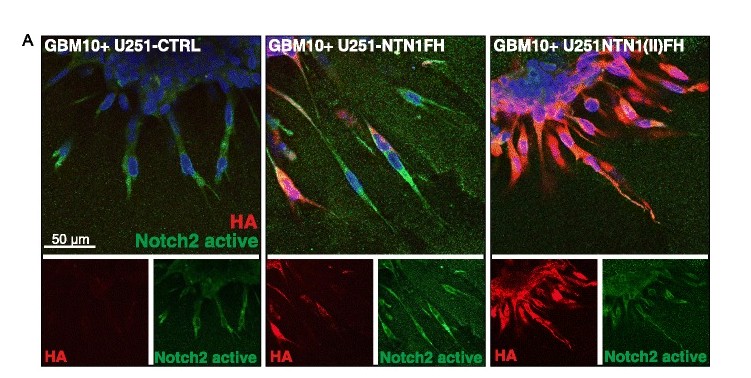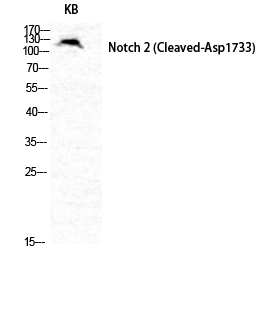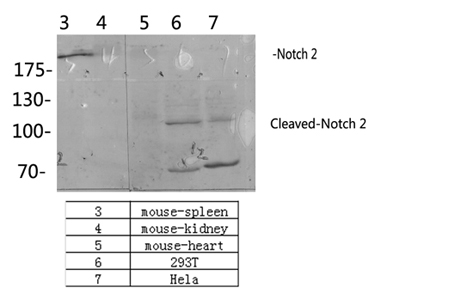Cleaved-Notch 2 (D1733) Polyclonal Antibody
- Catalog No.:YC0069
- Applications:IF;WB;IHC;ELISA
- Reactivity:Human;Mouse;Rat
- Target:
- Notch 2
- Fields:
- >>Endocrine resistance;>>Notch signaling pathway;>>Th1 and Th2 cell differentiation;>>Thyroid hormone signaling pathway;>>Human papillomavirus infection;>>Pathways in cancer;>>MicroRNAs in cancer;>>Chemical carcinogenesis - receptor activation;>>Breast cancer
- Gene Name:
- NOTCH2
- Protein Name:
- Neurogenic locus notch homolog protein 2
- Human Gene Id:
- 4853
- Human Swiss Prot No:
- Q04721
- Mouse Gene Id:
- 18129
- Mouse Swiss Prot No:
- O35516
- Rat Gene Id:
- 29492
- Rat Swiss Prot No:
- Q9QW30
- Immunogen:
- The antiserum was produced against synthesized peptide derived from human Notch 2. AA range:1684-1733
- Specificity:
- Cleaved-Notch 2 (D1733) Polyclonal Antibody detects endogenous levels of fragment of activated Notch 2 protein resulting from cleavage adjacent to D1733.
- Formulation:
- Liquid in PBS containing 50% glycerol, 0.5% BSA and 0.02% sodium azide.
- Source:
- Polyclonal, Rabbit,IgG
- Dilution:
- IF 1:50-200 WB 1:500 - 1:2000. IHC 1:100 - 1:300. ELISA: 1:40000. Not yet tested in other applications.
- Purification:
- The antibody was affinity-purified from rabbit antiserum by affinity-chromatography using epitope-specific immunogen.
- Concentration:
- 1 mg/ml
- Storage Stability:
- -15°C to -25°C/1 year(Do not lower than -25°C)
- Other Name:
- NOTCH2;Neurogenic locus notch homolog protein 2;Notch 2;hN2
- Observed Band(KD):
- 110(cleaved)kD
- Background:
- notch 2(NOTCH2) Homo sapiens This gene encodes a member of the Notch family. Members of this Type 1 transmembrane protein family share structural characteristics including an extracellular domain consisting of multiple epidermal growth factor-like (EGF) repeats, and an intracellular domain consisting of multiple, different domain types. Notch family members play a role in a variety of developmental processes by controlling cell fate decisions. The Notch signaling network is an evolutionarily conserved intercellular signaling pathway which regulates interactions between physically adjacent cells. In Drosophilia, notch interaction with its cell-bound ligands (delta, serrate) establishes an intercellular signaling pathway that plays a key role in development. Homologues of the notch-ligands have also been identified in human, but precise interactions between these ligands and the human notch homologues remain to be determined. This protein is cle
- Function:
- disease:Defects in NOTCH2 are the cause of Alagille syndrome type 2 (ALGS2) [MIM:610205]. Alagille syndrome is an autosomal dominant multisystem disorder defined clinically by hepatic bile duct paucity and cholestasis in association with cardiac, skeletal, and ophthalmologic manifestations. There are characteristic facial features and less frequent clinical involvement of the renal and vascular systems.,function:Functions as a receptor for membrane-bound ligands Jagged1, Jagged2 and Delta1 to regulate cell-fate determination. Upon ligand activation through the released notch intracellular domain (NICD) it forms a transcriptional activator complex with RBP-J kappa and activates genes of the enhancer of split locus. Affects the implementation of differentiation, proliferation and apoptotic programs.,PTM:Phosphorylated.,PTM:Synthesized in the endoplasmic reticulum as an inactive form which
- Subcellular Location:
- [Notch 2 extracellular truncation]: Cell membrane ; Single-pass type I membrane protein .; [Notch 2 intracellular domain]: Nucleus . Cytoplasm . Following proteolytical processing NICD is translocated to the nucleus. Retained at the cytoplasm by TCIM (PubMed:25985737). .
- Expression:
- Expressed in the brain, heart, kidney, lung, skeletal muscle and liver. Ubiquitously expressed in the embryo.
GOLM1 restricts colitis and colon tumorigenesis by ensuring Notch signaling equilibrium in intestinal homeostasis. Signal Transduction and Targeted Therapy Signal Transduct Tar. 2021 Apr;6(1):1-15 IF,IHC Mouse 1 : 100 ,1:200 Colon tissue
Motility of glioblastoma cells is driven by netrin-1 induced gain of stemness. JOURNAL OF EXPERIMENTAL & CLINICAL CANCER RESEARCH 2017 Jan 09 IF Human human GBM tissue
MiR‐199b‐5p inhibits osteogenic differentiation in ligamentum flavum cells by targeting JAG1 and modulating the Notch signalling pathway. JOURNAL OF CELLULAR AND MOLECULAR MEDICINE 2016 Dec 13 WB Human 1:500 ligamentum flavum cell
Epithelial Markers aSMA, Krt14, and Krt19 Unveil Elements of Murine Lacrimal Gland Morphogenesis and Maturation. Frontiers in Physiology 2017 Sep 26 IHC Mouse glands
Notch signaling pathways in human thoracic ossification of the ligamentum flavum. JOURNAL OF ORTHOPAEDIC RESEARCH J Orthop Res. 2016 Aug;34(8):1481-1491 IHC Human 1:200 ossification of the ligamentum flavum (OLF) tissue
High expression of NOTCH2 in gastric adenocarcinoma: A novel early diagnostic target JOURNAL OF GASTROENTEROLOGY AND HEPATOLOGY Mei Li IHC Human 1:300 gastric adenocarcinoma tissue
- June 19-2018
- WESTERN IMMUNOBLOTTING PROTOCOL
- June 19-2018
- IMMUNOHISTOCHEMISTRY-PARAFFIN PROTOCOL
- June 19-2018
- IMMUNOFLUORESCENCE PROTOCOL
- September 08-2020
- FLOW-CYTOMEYRT-PROTOCOL
- May 20-2022
- Cell-Based ELISA│解您多样本WB检测之困扰
- July 13-2018
- CELL-BASED-ELISA-PROTOCOL-FOR-ACETYL-PROTEIN
- July 13-2018
- CELL-BASED-ELISA-PROTOCOL-FOR-PHOSPHO-PROTEIN
- July 13-2018
- Antibody-FAQs
- Products Images
.jpg)
- Pu, Y., Song, Y., Zhang, M. et al. GOLM1 restricts colitis and colon tumorigenesis by ensuring Notch signaling equilibrium in intestinal homeostasis. Sig Transduct Target Ther 6, 148 (2021).

- Ylivinkka, Irene, et al. "Motility of glioblastoma cells is driven by netrin-1 induced gain of stemness." Journal of Experimental & Clinical Cancer Research 36.1 (2017): 9.
if-rat-lung2.jpg)
- Immunofluorescence analysis of rat-lung tissue. 1,Cleaved-Notch 2 (D1733) Polyclonal Antibody(red) was diluted at 1:200(4°C,overnight). 2, Cy3 labled Secondary antibody was diluted at 1:300(room temperature, 50min).3, Picture B: DAPI(blue) 10min. Picture A:Target. Picture B: DAPI. Picture C: merge of A+B
poly-ihc-human-liver.jpg)
- Immunohistochemical analysis of paraffin-embedded Human-liver tissue. 1,Cleaved-Notch 2 (D1733) Polyclonal Antibody was diluted at 1:200(4°C,overnight). 2, Sodium citrate pH 6.0 was used for antibody retrieval(>98°C,20min). 3,Secondary antibody was diluted at 1:200(room tempeRature, 30min). Negative control was used by secondary antibody only.
poly-ihc-rat-lung.jpg)
- Immunohistochemical analysis of paraffin-embedded Rat-lung tissue. 1,Cleaved-Notch 2 (D1733) Polyclonal Antibody was diluted at 1:200(4°C,overnight). 2, Sodium citrate pH 6.0 was used for antibody retrieval(>98°C,20min). 3,Secondary antibody was diluted at 1:200(room tempeRature, 30min). Negative control was used by secondary antibody only.
poly-ihc-rat-spleen.jpg)
- Immunohistochemical analysis of paraffin-embedded Rat-spleen tissue. 1,Cleaved-Notch 2 (D1733) Polyclonal Antibody was diluted at 1:200(4°C,overnight). 2, Sodium citrate pH 6.0 was used for antibody retrieval(>98°C,20min). 3,Secondary antibody was diluted at 1:200(room tempeRature, 30min). Negative control was used by secondary antibody only.
poly-ihc-mouse-kidney.jpg)
- Immunohistochemical analysis of paraffin-embedded Mouse-kidney tissue. 1,Cleaved-Notch 2 (D1733) Polyclonal Antibody was diluted at 1:200(4°C,overnight). 2, Sodium citrate pH 6.0 was used for antibody retrieval(>98°C,20min). 3,Secondary antibody was diluted at 1:200(room tempeRature, 30min). Negative control was used by secondary antibody only.

- Western Blot analysis of various cells using Cleaved-Notch 2 (D1733) Polyclonal Antibody diluted at 1:500
.jpg)
- Western Blot analysis of 293 cells using Cleaved-Notch 2 (D1733) Polyclonal Antibody diluted at 1:500

- The picture was kindly provided by our customer,antibody was diluted at 1:500

- Immunohistochemistry analysis of paraffin-embedded human brain tissue, using Notch 2 (Cleaved-Asp1733) Antibody. The picture on the right is blocked with the synthesized peptide.



